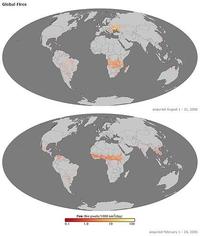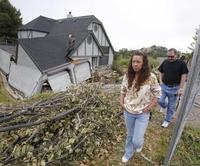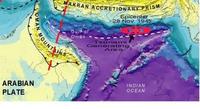-
As wildfires increase, scientists call for more study of terrestrial, atmospheric effects

Wildfire is a disturbance of ecosystems, and concerns continue to grow about the terrestrial and atmospheric effects of wildfires. Wildfires are expected to increase 50 percent across the United States under a changing climate, over 100 percent in areas of the West by 2050 as projected by some studies.
-
-
New filtration material to make petroleum refining cheaper, more efficient

A newly synthesized material might provide a dramatically improved method for separating the highest-octane components of gasoline. The material is a metal-organic framework, or MOF, which can be imagined as a sponge with microscopic holes.
-
-
Smartphone turned into handheld biosensor

Scientists and physicians in the field could soon run on-the-spot tests for environmental toxins, medical diagnostics, food safety and more with their smartphones. Researchers have developed a cradle and app for the iPhone that uses the phone’s built-in camera and processing power as a biosensor to detect toxins, proteins, bacteria, viruses, and other molecules.
-
-
GOP lawmakers urge Obama not to link Keystone decision to climate policies
Democrats who are uncomfortable with the Keystone XL pipeline have urged President Obama to consider attaching policies requiring cuts in greenhouse gases emissions to his approval of the project. Republican lawmakers are urging the president not to link approval of Keystone to climate change policies.
-
-
Administration more actively to support expansion of fracking
The Obama administration is leaning toward offering more active support for the expansion hydraulic fracturing, or fracking, despite the opposition of environmental groups.
-
-
House will see floor battle today over Keystone XL pipeline
Republican and Democrats lawmakers are set to engage in a fierce battle on the House floor over the fate of the Keystone XL project. Representative Lee Terry’s (R-Nebraska) proposed legislation to allow TransCanada to start construction of the Keystone XL pipeline, which runs from Hardisty, Canada through seven states to Houston, Texas. The bill will come to the House floor today.
-
-
Senator Hatch champions tech industry’s priorities in immigration reform

As the Senate Judiciary Committee continues to consider the bipartisan immigration reform bill, both supporters and opponents of the bill agree that one senator has emerged as a key voice on the issue: the 79-year old Orrin Hatch (R-Utah). Hatch has emerged as a champion of the U.S. technology industry, and while he supports the broad goal of immigration reform, he insists on shaping the legislation so it addresses the priorities and preferences of the tech industry, priorities and preferences which he sees as essential not only for the health of the industry, but for the health of the U.S. economy more generally.
-
-
Algae could become an important source of fuel in U.S.

A new analysis shows that the U.S. land and water resources could likely support the growth of enough algae to produce up to twenty-five billion gallons of algae-based fuel a year in the United States, one-twelfth of the country’s yearly needs.
-
-
Compressing air for renewable energy storage

Enough Northwest wind energy to power about 85,000 homes each month could be stored in porous rocks deep underground for later use, according to a new, comprehensive study. Researchers identified two unique methods for this energy storage approach and two eastern Washington locations to put them into practice.
-
-
DHS advises Michigan State U on football stadium safety
By all accounts, Michigan State University’s basketball team has been doing better over the years than the school’s football team (just think Magic Johnson). The university wants to raise the profile of its football team, and is building a new, $24 million stadium — but DHS advised the university that the stadium’s north side stands are too close to the gas tanks and pumps which serve the school’s motor pool. The university is now moving the gas tanks to a new location.
-
-
Asteroid 1998 QE2, nine times larger than cruise ship, to glide past earth

Two weeks from now, on 31May 2013, asteroid 1998 QE2 will sail serenely past Earth, getting no closer than about 3.6 million miles, or about fifteen times the distance between Earth and the moon. While QE2 is not of much interest to those astronomers and scientists on the lookout for hazardous asteroids, other asteroids are. NASA recently announced developing a first-ever mission to identify, capture, and relocate an asteroid for human exploration.
-
-
California community sinking into the ground, and engineers are baffled

Several homeowners in the community of Lake County, California are faced with a problem: their houses are sinking into the ground and they do not know why. The situation has been deteriorating steadily, and now mail delivery has been cancelled in the area, and city and county crews have been forced to change the subdivision’s sewage line to an overland pipe as a result of manhole collapses.
-
-
A “cauldron of events” has brought the nuclear industry to a halt
Until two years ago, people talked of a nuclear energy renaissance. Now the talk is about nuclear malaise. The Fukushima scare, the emergence of alternative energy sources as a result of fracking, and the lack of action on climate change – which means that limits on fossil fuels are not coming any time soon – have, in the words of one experts, brought the nuclear industry to a halt.
-
-
Hazard of Western Indian Ocean earthquake, tsunami greater than thought

Earthquakes similar in magnitude to the 2004 Sumatra earthquake could occur in an area beneath the Arabian Sea at the Makran subduction zone, according to recent research. The study suggests that the risk from undersea earthquakes and associated tsunami in this area of the Western Indian Ocean — which could threaten the coastlines of Pakistan, Iran, Oman, India, and potentially further afield — has been previously underestimated.
-
-
Quickly identifying chemical, biological warfare agents
For more than fifty years, researchers have been studying exactly how aspirin affects the human body. Despite thousands of publications on the topic, our understanding is still incomplete. Meanwhile, novel chemical and biological weapons have historically been mass produced within a year of discovery. Using current methods and technologies, researchers would require decades of study to gain a robust understanding of how new threat agents exert effects on human biological systems. DARPA wants to close this capability gap, which leaves U.S. forces vulnerable.
-
More headlines
The long view
Autonomous Vehicle Technology Vulnerable to Road Object Spoofing and Vanishing Attacks
Researchers have demonstrated the potentially hazardous vulnerabilities associated with the technology called LiDAR, or Light Detection and Ranging, many autonomous vehicles use to navigate streets, roads and highways. The researchers have shown how to use lasers to fool LiDAR into “seeing” objects that are not present and missing those that are – deficiencies that can cause unwarranted and unsafe braking or collisions.
Tantalizing Method to Study Cyberdeterrence
Tantalus is unlike most war games because it is experimental instead of experiential — the immersive game differs by overlapping scientific rigor and quantitative assessment methods with the experimental sciences, and experimental war gaming provides insightful data for real-world cyberattacks.
Prototype Self-Service Screening System Unveiled
TSA and DHS S&T unveiled a prototype checkpoint technology, the self-service screening system, at Harry Reid International Airport (LAS) in Las Vegas, NV. The aim is to provide a near self-sufficient passenger screening process while enabling passengers to directly receive on-person alarm information and allow for the passenger self-resolution of those alarms.
Falling Space Debris: How High Is the Risk I'll Get Hit?
An International Space Station battery fell back to Earth and, luckily, splashed down harmlessly in the Atlantic. Should we have worried? Space debris reenters our atmosphere every week.
Testing Cutting-Edge Counter-Drone Technology
Drones have many positive applications, bad actors can use them for nefarious purposes. Two recent field demonstrations brought government, academia, and industry together to evaluate innovative counter-unmanned aircraft systems.
Strengthening the Grid’s ‘Backbone’ with Hydropower
Argonne-led studies investigate how hydropower could help add more clean energy to the grid, how it generates value as grids add more renewable energy, and how liner technology can improve hydropower efficiency.
